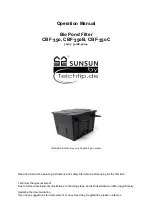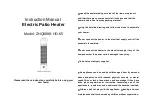
Page 24
The proper chemical balance in spa water is
more critical than in a swimming pool heater opera-
tion. Due to the spa’s size, high water temperature
and heavy usage, chemical values in a spa can vary
greatly. This chemical imbalance can result in
unsanitary water conditions, and affect the life of the
heater.
Proper chemical balances are necessary for
sanitary bathing conditions as well as ensuring your
heater’s long life. Kits are available from your local
pool supply dealer for making the various tests for
mineral content. One of these kits will detect copper
in the system. This is usually a warning that corrosion
is taking place, possibly due to a low pH value
combined with other chemistry problems. The
condition can be corrected by changing the spa water
and closely monitoring the pH factor and chemical
properties of the water. Be sure to keep your
chemical levels within the values indicated in Table 7.
Water Pik Technologies does not warrant heat
exchangers damaged by corrosive chemical
levels or excess dissolved solids in pool or spa
water.
For spas, it is also necessary to perform water
changes in addition to chemical treatment. It is
recommended to change the spa water every 60 days
for light usage and every 30 days if usage is heavy.
Table 7. Chemical Concentration Levels*
T e s t
Recommended Level
Free Chlorine or
1.0 to 3.0 ppm (3.0 to 5.0 spa)
Bromine
2.0 to 4.0 ppm (3.0 to 5.0 spa)
pH
7.4 to 7.6
Total Alkalinity (TA)
80 to 120 ppm
Calcium Hardness (CH)
200 to 400 ppm
Cyanuric Acid
30 to 50 ppm
Total Dissolved Solids (TDS)
Less than 2000 ppm
Copper
0 ppm
* Concentration levels taken from “Basic Pool and Spa
Technology” published by NSPI (National Spa and Pool Institute).
Figure 20. Heater drain locations.
Figure 21. Pressure switch copper tubing.
8.2 Seasonal Care
CAUTION
Do not operate this heater outdoors at
temperatures below 20 degrees Fahrenheit (°F)
(-7 degrees Celsius [°C]).
8.2.1 Spring and Fall Operation
During periods when the pool is only going to be
used occasionally, turn the temperature control down to
the MIN setting. This prevents the pool water from
becoming chilled, and minimizes the time required to
raise the pool water back up to the desired temperature.
In areas subject to only short freeze periods, turn
off the heater and run the pump continuously for the
length of the freeze period.
If the heater is not going to be used for a long
period of time, shut it down completely. Follow the
instructions found on the inside of the heater, or page
21 of this manual.















































